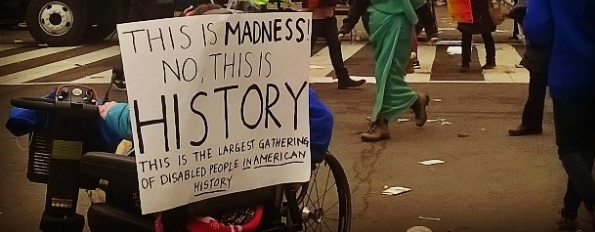What started out as a small group of women coming together after the election turned into one of the largest demonstrations in American history. It was for women. It was peaceful. It was sassy. And importantly, it incorporated a population that is often excluded from progressive causes: The disabled community. But you might not have known that from media coverage or even the programming of the Women’s March itself.
When you have a disability getting to and participating in demonstrations involves detailed advance planning. In order to help out, the Women’s March had an ADA tent. I volunteered While working in the ADA tent, I heard from many people who had difficulty on buses and airlines, difficulty trying to rent or borrow mobility equipment, and difficulty asking friends and family to help support them during the march. I asked a friend to come, not only because I wanted her to be a part of something I thought would be a powerful moment in history, but because I did not feel comfortable going alone. I needed her to be there for me.
ADA volunteers were barely recognized, both on stage and in the media surrounding the Women’s March. While over 45,000 people with disabilities participated, there was little mention or acknowledgement of disability onstage from the presenters. Tammy Duckworth, a senator from Illinois with a disability, only casually mentioned the ADA and did not speak to the struggles that people with disabilities face.
There were also physical access problems at the Women’s March itself. The crowds pushed and shoved, even in their attempt to be peaceful. Trash and debris littered the ground. The outages and delays of trains, buses, and elevators made the event extraordinarily challenging for me and other people with disabilities to navigate.
Many people with disabilities couldn’t even get to the ADA tent. There was no way to push through the crowds to get there. The ADA tent actually had to start turning away volunteers because people couldn’t reach us, in person or electronically, to ask for help. Many of the people I talked to say they didn’t use the bathroom all day, because they couldn’t. Either they couldn’t find accessible restrooms, or couldn’t get to those restrooms because of the crowd.
Despite these challenges, thousands of disabled people came out and supported a cause we believed in. So many people, disabled and non-disabled, came to the ADA tent and asked how they could help. They volunteered to support others so they could be present and enjoy the march, in solidarity with the disabled community. Our singing, laughing, and chanting uplifted and united us.
Several disabled people that I have talked to have mentioned that they are not sure if they would march again. Initially, I wasn’t sure myself. But I am proud of myself and my disabled brothers and sisters. When we were faced with challenges we stood up in the face of adversity. Yes, it was hard, but here I am. Here we are. We are being noticed. All we need to do is keep moving forward, together.

